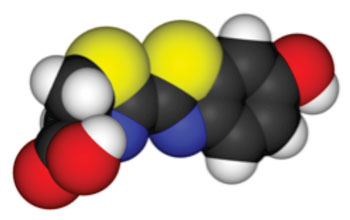Diagnosing Liver Cancer Using Genetically Modified Probiotic Bacteria
By LabMedica International staff writers
Posted on 08 Jun 2015
A genetically engineered variety of the probiotic bacterium Escherichia coli Nissle 1917 was used to generate a luminescent diagnostic biomarker that could be detected in the urine of rodents with liver tumors.Posted on 08 Jun 2015
Investigators at the Massachusetts Institute of Technology (Cambridge, MA, USA) and the University of California, San Diego (USA) genetically engineered E. coli Nissle 1917 to carry the gene that encodes a lacZ reporter enzyme, which would normally cleave lactose into glucose and galactose. For the current study galactose linked-luciferin was provided as the substrate in test rodents, and the enzyme acted on this complex to produce free, luminescent luciferin, which was excreted and could be detected in the urine.

Image: A space-filling model of firefly luciferin. Color coding: yellow = sulfur; blue = nitrogen; black = carbon; red = oxygen; white = hydrogen (Photo courtesy of Wikimedia Commons).
The investigators reported in the May 27, 2015, online edition of the journal Science Translational Medicine that E. coli Nissle 1917 robustly colonized tumor tissue in rodent models of liver metastasis after oral delivery but did not colonize healthy organs or fibrotic liver tissue. The microbial diagnostic generated a high-contrast urine signal through selective expansion in liver metastases (106-fold enrichment) and high expression of the lacZ reporter maintained by engineering a stable plasmid system. No deleterious health effects were detected in the mice more than 12 months after oral delivery.
The orally delivered bacteria did not accumulate in tumors all over the body, but did become established in nearly 90% of metastatic tumors in mice with colon cancer that had spread to the liver.
"We realized that if we gave a probiotic, we were not going to be able to get bacteria concentrations high enough to colonize the tumors all over the body, but we hypothesized that if we had tumors in the liver they would get the highest dose from an oral delivery," said senior author Dr. Sangeeta Bhatia, professor of health sciences, electrical engineering, and computer science, at the Massachusetts Institute of Technology. "There are interventions, like local surgery or local ablation, that physicians can perform if the spread of disease in the liver is confined, and because the liver can regenerate, these interventions are tolerated. New data are showing that those patients have a higher survival rate, so there is a particular need for detecting early metastasis in the liver."
Related Links:
Massachusetts Institute of Technology
University of California, San Diego













